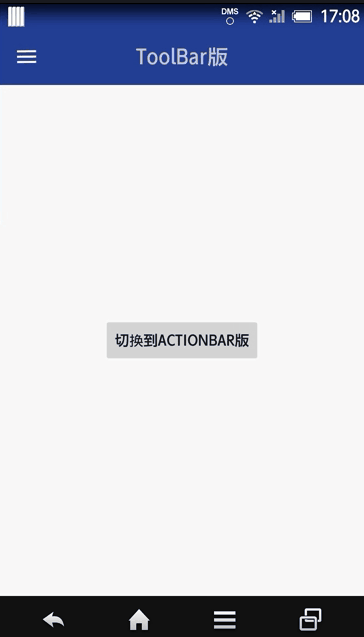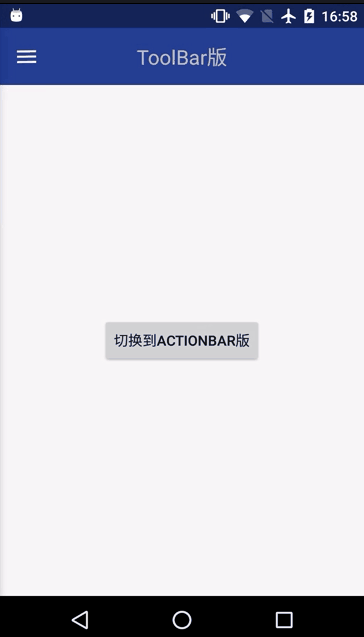Android通知栏沉浸式/透明化完整解决方案
转载请注明出处:http://www.cnblogs.com/cnwutianhao/p/6640649.html
参考文献:https://github.com/ljgsonx/adaptiveStatusBar
Google在Android 4.4版本加入了半透明的界面样式,在Android 5.0的时候推出了Material Design的概念。
这些样式的加入使得原本死板、丑陋、和App颜色不一致的通知栏变得更亲和、顺眼、用户体验更友好。
作者是常年做对日项目的,对日项目以界面简洁功能强大而著称。最近客户要求UI方面做一些改变,让App看上去给用户感觉更友好。所以就提到了Android 4.4以后的通知栏问题。
网上关于通知栏的文章铺天盖地,什么沉浸式,什么半透明。。。挺会拽词。也不乏有Android大神也写过类似的文章,但是那文章能看?长篇大论,程序员够累了,哪有那些时间看你在那里车轱辘话满天飞,说了一大顿表达不明白,浪费时间,写的一堆垃圾文章。
本篇文章杜绝冗余,做到最简单,最实用,对日项目比的不是代码量,而是最少的代码写出最漂亮的程序。
文章对应的项目已上传到Github,欢迎Star,欢迎Fork。地址:https://github.com/cnwutianhao/ImmersiveDemo
先上Gif图,Android 4.4 和 Android 6.0 实现样式效果之后的对比图
Android 4.4 Android 6.0


实现样式效果我们有两种方案
①DrawerLayout+Toolbar
②ActionBar
下面我们就来一一实现
①DrawerLayout+Toolbar
添加依赖库(谷歌提供)
- compile 'com.android.support:design:25.3.1'
布局代码1:使用 DrawerLayout做最外层,引入NavigationView侧边抽屉控件
- <?xml version="1.0" encoding="utf-8"?>
- <android.support.v4.widget.DrawerLayout xmlns:android="http://schemas.android.com/apk/res/android"
- xmlns:app="http://schemas.android.com/apk/res-auto"
- xmlns:tools="http://schemas.android.com/tools"
- android:id="@+id/id_drawerlayout"
- android:layout_width="match_parent"
- android:layout_height="match_parent"
- tools:context="com.tnnowu.android.demo17032801.MainActivity">
- <include layout="@layout/content_layout" />
- <android.support.design.widget.NavigationView
- android:id="@+id/id_navigationview"
- android:layout_width="match_parent"
- android:layout_height="match_parent"
- android:layout_gravity="left"
- app:itemTextColor="@color/c_light_gray3" />
- </android.support.v4.widget.DrawerLayout>
布局代码2:里层嵌套Toolbar
- <?xml version="1.0" encoding="utf-8"?>
- <LinearLayout xmlns:android="http://schemas.android.com/apk/res/android"
- xmlns:app="http://schemas.android.com/apk/res-auto"
- android:layout_width="match_parent"
- android:layout_height="match_parent"
- android:orientation="vertical">
- <android.support.v7.widget.Toolbar
- android:id="@+id/toolbar"
- android:layout_width="match_parent"
- android:layout_height="wrap_content"
- android:background="#30469b"
- android:paddingTop="@dimen/toolbar_padding_top"
- app:popupTheme="@style/ThemeOverlay.AppCompat.Light"
- app:theme="@style/ThemeOverlay.AppCompat.Dark.ActionBar">
- <TextView
- android:layout_width="wrap_content"
- android:layout_height="wrap_content"
- android:layout_gravity="center"
- android:text="ToolBar版"
- android:textSize="20sp" />
- </android.support.v7.widget.Toolbar>
- <!--内容显示布局-->
- <RelativeLayout
- android:layout_width="match_parent"
- android:layout_height="match_parent">
- <Button
- android:id="@+id/goToActionBar"
- android:layout_width="wrap_content"
- android:layout_height="wrap_content"
- android:layout_centerInParent="true"
- android:text="切换到ActionBar版" />
- </RelativeLayout>
- </LinearLayout>
Style样式:无ActionBar
- <style name="AppThemeNoActionBar" parent="Theme.AppCompat.Light.NoActionBar">
- <!-- Customize your theme here. -->
- <item name="colorPrimary">@color/colorPrimary</item>
- <item name="colorPrimaryDark">@color/colorPrimaryDark</item>
- <item name="colorAccent">@color/colorAccent</item>
- </style>
主程序代码:除了要在onCreate()里面初始化 DrawerLayout、NavigationView、Toolbar控件 即initViews(),还要在onCreate()里面添加手机系统版本判断和相应的样式适配initImmersive()
- private void initViews() {
- mDrawerLayout = (DrawerLayout) findViewById(R.id.id_drawerlayout);
- mNagigationView = (NavigationView) findViewById(R.id.id_navigationview);
- mNagigationView.inflateHeaderView(R.layout.header_nav);
- mNagigationView.inflateMenu(R.menu.menu_nav);
- mToolbar = (Toolbar) findViewById(R.id.toolbar);
- mBtn = (Button) findViewById(R.id.goToActionBar);
- mToolbar.setTitle("");
- if (mToolbar != null) {
- setSupportActionBar(mToolbar);
- }
- ActionBarDrawerToggle mActionBarDrawerToggle = new ActionBarDrawerToggle(this, mDrawerLayout, mToolbar, R.string.open, R.string.close);
- mActionBarDrawerToggle.syncState();
- mDrawerLayout.setDrawerListener(mActionBarDrawerToggle);
- mBtn.setOnClickListener(new View.OnClickListener() {
- @Override
- public void onClick(View v) {
- startActivity(new Intent(MainActivity.this, DemoActionBarActivity.class));
- }
- });
- }
- private void initImmersive() {
- if (Build.VERSION.SDK_INT >= Build.VERSION_CODES.KITKAT) {
- WindowManager.LayoutParams localLayoutParams = getWindow().getAttributes();
- localLayoutParams.flags = (WindowManager.LayoutParams.FLAG_TRANSLUCENT_STATUS | localLayoutParams.flags);
- if (Build.VERSION.SDK_INT < Build.VERSION_CODES.LOLLIPOP) {
- //将侧边栏顶部延伸至status bar
- mDrawerLayout.setFitsSystemWindows(true);
- //将主页面顶部延伸至status bar;虽默认为false,但经测试,DrawerLayout需显示设置
- mDrawerLayout.setClipToPadding(false);
- }
- }
- }
这样Drawlayout + Toolbar就实现了样式改变。
②ActionBar
布局代码
- <?xml version="1.0" encoding="utf-8"?>
- <LinearLayout xmlns:android="http://schemas.android.com/apk/res/android"
- android:layout_width="match_parent"
- android:layout_height="match_parent"
- android:background="@color/colorPrimary"
- android:fitsSystemWindows="true"
- android:orientation="vertical">
- <!--内容显示布局-->
- <RelativeLayout
- android:layout_width="match_parent"
- android:layout_height="match_parent"
- android:background="@color/c_light_white">
- <Button
- android:id="@+id/goBack"
- android:layout_width="wrap_content"
- android:layout_height="wrap_content"
- android:layout_centerInParent="true"
- android:text="返回到ToolBar版" />
- </RelativeLayout>
- </LinearLayout>
Style样式:有ActionBar
- <style name="AppThemeActionBar" parent="Theme.AppCompat.Light.DarkActionBar">
- <!-- Customize your theme here. -->
- <item name="colorPrimary">@color/colorPrimary</item>
- <item name="colorPrimaryDark">@color/colorPrimaryDark</item>
- <item name="colorAccent">@color/colorAccent</item>
- </style>
主程序代码:
- public class DemoActionBarActivity extends AppCompatActivity {
- private Button mBtn;
- @Override
- protected void onCreate(Bundle savedInstanceState) {
- super.onCreate(savedInstanceState);
- setContentView(R.layout.activity_main_actionbar);
- if (Build.VERSION.SDK_INT >= Build.VERSION_CODES.KITKAT) {
- WindowManager.LayoutParams localLayoutParams = getWindow().getAttributes();
- localLayoutParams.flags = (WindowManager.LayoutParams.FLAG_TRANSLUCENT_STATUS | localLayoutParams.flags);
- }
- initView();
- }
- private void initView() {
- mBtn = (Button) findViewById(R.id.goBack);
- mBtn.setOnClickListener(new View.OnClickListener() {
- @Override
- public void onClick(View v) {
- finish();
- }
- });
- }
- }
这样ActionBar就实现了样式改变。
无冗余代码,对日项目都在用的代码你为何不尝试使用。
关注我的新浪微博,获取更多Android开发资讯!
关注科技评论家,领略科技、创新、教育以及最大化人类智慧与想象力!
Android通知栏沉浸式/透明化完整解决方案的更多相关文章
- Android:沉浸式状态栏(一)工具类
参考自Android 沉浸式状态栏完美解决方案 基本功能 状态栏深色或浅色图标切换 自定义状态栏背景 设置沉浸式状态栏 先准备几个工具类 1.SystemBarTintManager package ...
- Android 中沉浸式状态栏实现
Android 中沉浸式状态栏实现方式如下 计算状态栏高度及调用沉浸式状态栏的相关API方法 package com.example.status; import android.annotation ...
- 8.Android 系统状态栏沉浸式/透明化解决方案
转载:http://www.jianshu.com/p/34a8b40b9308 前言 网上已经有很多有关于系统状态栏的解决方案,这篇文章也不会有什么新奇的解决方案,都是本人经过自己试验,统计提炼出来 ...
- Android App 沉浸式状态栏解决方案
伴随着 Android 5.0 发布的 Material Design,让 Android 应用告别了以前的工程师审美,迎来了全新的界面,灵动的交互,也让越来越多的 App 开始遵从 material ...
- Android 沉浸式状态栏完美解决方案
现在搜索Android 沉浸式状态栏,真的是一堆一堆,写的特别多,但是真正用的舒服的真没有,在这里自己整理一下开发记录 注意,在使用这个步骤过程之前,请把之前设置的代码注释一下 把布局带有androi ...
- 81.Android之沉浸式状态栏攻略
转载:http://blog.csdn.net/lmj623565791/article/details/48649563/ 一.概述 近期注意到QQ新版使用了沉浸式状态栏,ok,先声明一下:本篇博客 ...
- 【Android】沉浸式状态栏实现
在Android4.4(API 19)及以后的版本中都增加了对沉浸式状态栏的支持,实现起来也很简单,将application的主题稍作修改即可: <style name="AppThe ...
- Android 之 沉浸式状态栏及顶部状态栏背景色设置
现在很多应用都引用了沉浸式状态栏,如QQ,效果下图: 效果很酷炫,其实设置也很简单.但是,需要注意的是,这种效果只能在API19以及以上版本中才能够做到. 方法一: 首先,如果想让界面Activity ...
- Android中沉浸式状态栏的应用
在Android5.0版本后,谷歌公司为Android系统加入了很多新特性,刷新了Android用户的体验度.而其中的一个新特性就是沉浸式状态栏.那么问题来了,很多非移动端的小伙伴就要问了,什么是沉浸 ...
随机推荐
- [转载]在Windows下搭建Android开发环境
http://jingyan.baidu.com/article/bea41d437a41b6b4c51be6c1.html 在Windows下搭建Android开发环境 | 浏览:30780 | 更 ...
- jquery操作select(取值,设置选中)[转]
每一次操作select的时候,总是要出来翻一下资料,不如自己总结一下,以后就翻这里了. 比如<select class="selector"></select&g ...
- 20155227 2016-2017-2 《Java程序设计》第五周学习总结
20155227 2016-2017-2 <Java程序设计>第五周学习总结 教材学习内容总结 语法与继承架构 使用try...catch JVM会尝试执行try区块中的程序代码,如果发生 ...
- RabbitMq简单应用
服务端: <?php //配置信息 $conn_args = array( 'host' => '127.0.0.1', 'port' => '5672', 'login' => ...
- win8开wifi共享无法使用的问题解决办法
相信现在不少人都安装了windows8操作系统,因为windows8这个全新的操作系统用起来 确实挺强大,包括漂亮的开始屏,但是不得不说这个系统的兼容性还是有待提高,所以win8我的 装了又卸,卸了又 ...
- 第10月第20天 afnetwork like MKNetworkEngine http post
1. + (AFHTTPRequestOperation *)requestSellerWithCompletion:(requestFinishedCompletionBlock)successBl ...
- LVTTL与LVCMOS区别
TTL电平的VIH/VIL一般是2V/0.8V,VOH/VOL一般是 2.4V/0.4V,不论是3.3V还是5V的TTL都一样的:CMOS的VIH/VIL一般是70%VCC/30%VCC,VOH/VO ...
- 八、mini2440裸机程序之UART(2)UART0与PC串口通信【转】
转自:http://blog.csdn.net/shengnan_wu/article/details/8309417 版权声明:本文为博主原创文章,未经博主允许不得转载. 1.相关原理图 2.相关寄 ...
- Oracle 数据库和监听器开机自启动两种实现方法
数据库和监听器开机自启动 编辑oratab文件: 修改:orcl:/u01/app/oracle/product/11.2.0/db_1:N orcl:/u01/app/or ...
- 【前端vue开发】vue开发输入姓名,电话,公司表单提交组件
<template> <div id="parti-info"> <div> <span>您的姓名:</span> &l ...
